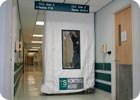A Comprehensive System Refurbishing

For many of the country’s growing regional healthcare systems, making investments to ensure the security and safety of staff, patients and visitors is integral element of healthy growth.
Nowhere is this more paramount than within St. Joseph’s Hospital in Tampa, Fla., a multi-hospital organization embarking on an ambitious five-year security improvement plan to upgrade its security systems and procedures. The plan will help the state’s fifth-largest healthcare system meet the ever changing security challenges with a system that leverages the hospital’s existing infrastructure to work with new investments in scalable, state-of-the-art video surveillance and access control technology.
CREATING CONSISTENCY
Part of the BayCare Health System, St. Joseph’s Hospital is home to three separate facilities on its 38-acre campus – St. Joseph’s Hospital, St. Joseph’s Children’s Hospital and St. Joseph’s Women’s Hospital. With ongoing renovations to all three hospital buildings, as well as the design and construction of St. Joseph’s North, a new hospital opening in 2009, it was necessary to identify and address current security concerns of the existing campus but also incorporate new construction as part of the five-year plan.
Hospital security staff and executive management worked with Securitas Systems USA to design the system. “We knew we needed technical advice on how to leverage a security system upgrade into the best investment for the future,” said Dodd Day, manager, safety, security and emergency preparedness for St. Joseph’s Hospital. “The company did an excellent job of developing solutions for the hospital’s security and safety needs that will make the most of our existing equipment while keeping us current with new technology.”

CULMINATION TO COME
Through a comprehensive risk assessment of all of the St. Joseph’s Hospital facilities, the hospital security staff worked with systems integrator Securitas to identify priority areas where technology could be deployed to improve security. That assessment led to a five-year course of improvements that, when culminated, will result in a complete IP and server-based system that will use the hospital’s existing IT network.
One major focus of the security upgrade is the deployment of digital video surveillance and network-based digital recording, using the hospital’s existing network. Day and his team decided to forgo an investment into DVR technology in favor of network video recorders and a server-based architecture. With that approach, the hospital will be able to maintain central monitoring at one facility through a hub and spoke system, using the Nextiva video surveillance solution from Verint Systems.

OPERATIONAL BENEFITS
Not only will the project modernize security within St. Joseph’s Hospital, it will also bring a significant number of operational benefits to the hospital. Providing a safe and secure work environment becomes a competitive advantage for the retention of nurses, who, according to federal workplace violence statistics, top the list of workers likely to be victims of violence at work. Within St. Joseph’s Women’s Hospital, which boasts one of the busiest labor and delivery units in the Tampa Bay area, the network-based camera system will enhance existing physical security measures to provide a safe and secure environment for newborns and their mothers.
Other areas identified with particular risks that will also be addressed as part of the five-year plan include pharmacy areas of the hospital as well as systems to mitigate the theft of medical equipment, such as endoscopes, Day said. Asset tracking of equipment will be first deployed in St. Joseph’s North, and then potentially rolled out to other facilities.

General use areas of the hospital will also receive special attention. The hospital’s new 10-story parking garage, one of five such facilities on the St. Joseph’s Hospital campus, was identified as being vulnerable to vehicle crime during the risk assessment. IP cameras will be used in the new garage to help reduce this risk. The cafeteria, which serves hospital staff and visitors, will be renovated and outfitted with surveillance to prevent walkouts and internal loss, according to Don Knowles, account executive, healthcare division, Securitas Systems USA.
“In a hospital setting, you have to be ensure that you understand the needs of each individual department, from the children’s hospital to the women’s center to the maintenance department,” Knowles said. “As a security provider, it’s our job to make security improvements meet the needs of the occupants as best we can while still adhering to the standards outlined by our clients.”
Utilizing the Healthcare Solutions Group, a specialized business unit of Securitas that works within the hospital and healthcare community to offer integrated security solutions and non- traditional risk management solutions, each department in the hospital can benefit from this comprehensive solution that has a clearly defined return on investment and a return on risk.

SIDEBAR: The Provider-Customer Process
St. Joseph’s Hospital is part of the St. Joseph’s-Baptist Health Care system, a community health alliance that brings together St. Joseph’s Hospital, St. Joseph’s Women’s Hospital and St. Joseph’s Children’s Hospital of Tampa, and South Florida Baptist Hospital in Plant City. St. Joseph’s Hospital has served the health care needs of the Tampa Bay community since 1934, and is the largest not-for-profit health care provider in Hillsborough County.
Because of the various locations and varying security systems, St. Joseph’s felt compelled to seek advice on installing a new comprehensive system.
At the end of the project’s first year, a total of 96 IP cameras will be operational throughout the hospital, as well as the beginning stages of the server architecture, said Don Knowles, account executive, healthcare division for Securitas. Nearly 40 percent of the cameras are part of the hospital’s existing video infrastructure, outfitted with encoders.
“We have a terrific partnership with St. Joseph’s Hospital’s IT department and sought their approval of the project from the beginning,” Knowles said. Of particular interest to IT personnel was the ability to deploy the same off-the-shelf server and storage hardware already used throughout the IT network of BayCare Health System, St. Joseph’s Hospital’s parent organization, which includes nine not-for-profit hospitals in the Tampa Bay area.
“Our approach allows the client to use hardware they are familiar with,” Knowles said. “Instead of being locked into buying proprietary hardware, they can continue purchasing off the shelf components through their IT reseller.”
A longtime partner of St. Joseph’s Hospital, as well as several other healthcare organizations in the Southeast, Knowles and his team know they will be adjusting the hospital’s five-year plan several times throughout the security upgrade.
“You have to be able to adapt to the changes that are going to occur within the organization and not be stagnant on your use of technology; it’s got to be a living breathing document that adapts with the changing needs of the hospital,” Knowles said. “With our deployment of IP technology at St. Joseph’s Hospital, the open architecture will allow us to easily add scale and additional capabilities to the system at any time.”
Looking for a reprint of this article?
From high-res PDFs to custom plaques, order your copy today!







